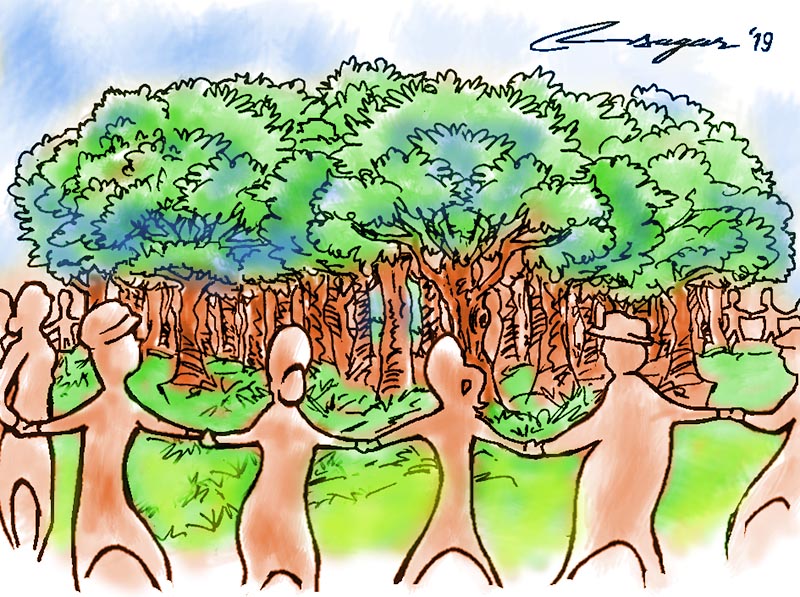Community in conservation: More benefits for locals
Conservation feats are a result of trust among the local people, government authorities and stakeholders. The cost incurred, and benefits derived from conservation are of utmost importance for the welfare of communities
Protecting life on both land and water has become a priority for the global community following the agreement made by countries across the world to do their bit and contribute towards the sustainable development goals 2015-2030. Nepal, with although a relatively poor development status but rich biodiversity, has surely been taking its contribution towards the SDGs seriously. This landlocked nation has more than 44% landmass covered by forest and about a quarter of the country’s land comes under the protected area status, creating ample opportunities for the nations’ development through conservation owned by its people.
Nepal has been demonstrating exemplary work since the mid-1970s when it comes to protecting the country’s forests, thanks to the dedication of the local communities who understand the value of forests. This Himalayan nation has been an archetype in the case of participatory forest management - managing natural resources as per the needs of the people and optimising the benefits derived from the resources while giving utmost priority to nature conservation. In the last 35 years, more than 20,000 community-based institutions have devoted themselves in protecting, managing and utilising forest resources, and the quality of these forests, which are home to our stunning wildlife, have been a proof of that dedication and commitment.
There are multiple evidences of how the acceptance of conservation has resulted in many success stories across Nepal. Be it the fifty and more households in Arunkhola in Nawalparasi district, who switched from forest dependence to leaf plate making enterprises, or the youth in Kanchanpur who have gone onto becoming conservationists despite losing their family members to human-wildlife conflict or the young souls in Khata Corridor that connects Nepal’s Bardiya National Park with India’s Katerniyaghat Wildlife Sanctuary, who are leading a local voluntary group of young people called Community-based anti-poaching Unit (CBAPUs), all of which tell the tale of one’s love for nature.
Despite the maximum number of human-wildlife interactions in the Terai Arc Landscape - a pioneer landscape of Nepal, which is home to many endangered faunas in the tropical forest of the Terai region, the rate of wildlife retaliation is minimal. Today, there are over 5,000 local youths affiliated to 500 CBAPUs across the Terai Arc Landscape, and these young hearts along with their community are making every attempt to minimise animal and human interface and retaliatory killings.
Among others, these include using preventive measures, such as fencing and predator-proof pens to shelter the animals. Additionally, compensation mechanism set up by the Government of Nepal for human-wildlife victims and the support from conservation organisations and their initiatives have helped provide some relief to people living in close proximity with forests.
Despite the challenges, community participation in national parks and other conservation management areas has brought new opportunities for the local people. As of today, 23.39% of the country’s land is protected, out of which 60% is managed as multiple use zone with a larger stake of the local community through buffer zone and conservation area management approach. Indigenous people living close to the parks have received direct benefits through community-based tourism.
Multiple stakeholders’ engagement in conservation has created a win-win situation for both nature and people. While on one hand, people have been doing everything to preserve the environment, nature, in turn, has given enough reasons to lure tourists and secure the livelihood of those living close to the forest. At present, there are 202 households running community homestay across Terai Arc Nepal through 17 community homestay committees who make an annual transaction of more than a million rupees. As a leading conservation organisation working in the government, WWF Nepal has been supporting the local communities.
Conservation feats are a result of trust among the local people, government authorities and stakeholders. The cost incurred, and benefits derived from conservation are of utmost importance for the welfare of communities, and it is the duty of every individual to rightly judge the value of nature and contribute towards its preservation. In many parts of Nepal, it is reported that Community Forest User Groups (CFUGs) have been instrumental in the overall development of the community. CFUGs have managed to bring about a change in the behaviour of people by declaring community forests as ‘zero-grazing zones’ and making them switch from otherwise rearing their cattle in the forest to making improved cattle sheds and planting more fodder in their farmyards.
The bottom line: To carry out sustainable development practices, the suggested road ahead for all government stakeholders, particularly the local government, is focussing on the local people and understanding how they would access more benefits from natural resource management. As the saying goes, ‘Think globally, act locally,’ if brought into action will ensure wise use of resources, more benefits for people and flourishing conservation.’
Gotame is a programme manager at WWF Nepal






